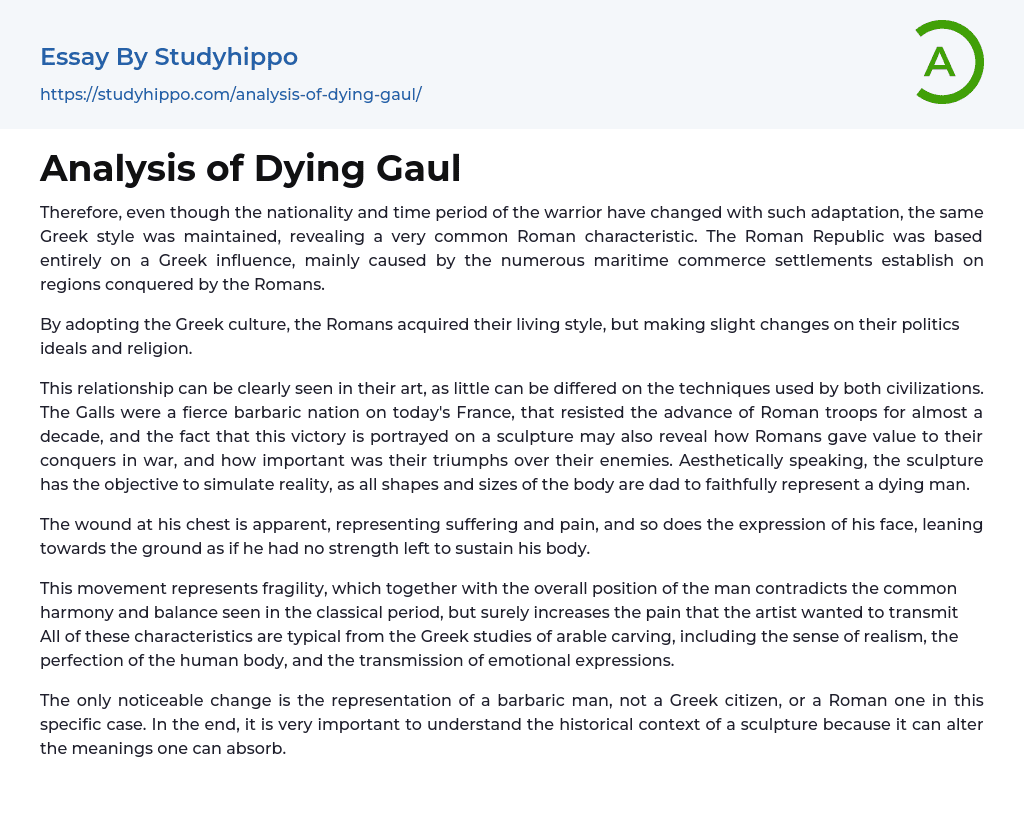Therefore, even though the nationality and time period of the warrior have changed with such adaptation, the same Greek style was maintained, revealing a very common Roman characteristic. The Roman Republic was based entirely on a Greek influence, mainly caused by the numerous maritime commerce settlements establish on regions conquered by the Romans.
By adopting the Greek culture, the Romans acquired their living style, but making slight changes on their politics ideals and religion.
This relationship can be clearly seen in their art, as little can be differed on the techniques used by both civilizations. The Galls were a fierce barbaric nation on today's France, that resisted the advance of Roman troops for almost a decade, and the fact that this victory is portrayed on a sculpture may also reveal how Romans gave value to their
...conquers in war, and how important was their triumphs over their enemies. Aesthetically speaking, the sculpture has the objective to simulate reality, as all shapes and sizes of the body are dad to faithfully represent a dying man.
The wound at his chest is apparent, representing suffering and pain, and so does the expression of his face, leaning towards the ground as if he had no strength left to sustain his body.
This movement represents fragility, which together with the overall position of the man contradicts the common harmony and balance seen in the classical period, but surely increases the pain that the artist wanted to transmit All of these characteristics are typical from the Greek studies of arable carving, including the sense of realism, the perfection of the human body, and the transmission of emotional expressions.
The
only noticeable change is the representation of a barbaric man, not a Greek citizen, or a Roman one in this specific case. In the end, it is very important to understand the historical context of a sculpture because it can alter the meanings one can absorb.
- Cloning essays
- Medical Ethics essays
- Patient essays
- Therapy essays
- drugs essays
- Cannabis essays
- Aspirin essays
- Cardiology essays
- Hemoglobin essays
- Pharmacology essays
- Surgery essays
- alternative medicine essays
- Plastic Surgery essays
- Organ Donation essays
- Vaccines essays
- Medical essays
- Dentist essays
- Psychological Trauma essays
- Physical therapy essays
- Cold essays
- Cocaine essays
- Why Marijuana Should Be Legalized essays
- Drug Abuse essays
- Teenage Drug Abuse essays
- Heart Disease essays
- Artery essays
- Animals essays
- Charles Darwin essays
- Agriculture essays
- Archaeology essays
- Moon essays
- Space Exploration essays
- Sun essays
- Universe essays
- Birds essays
- Horse essays
- Bear essays
- Butterfly essays
- Cat essays
- Dolphin essays
- Monkey essays
- Tiger essays
- Whale essays
- Lion essays
- Elephant essays
- Mythology essays
- Time Travel essays
- Discovery essays
- Thomas Edison essays
- Linguistics essays




